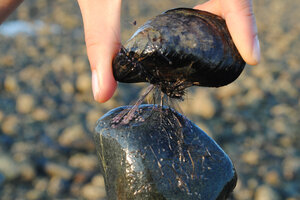Mussel filaments prove that harder isn't necessarily stronger
Researchers at MIT have found mussels adhere themselves to rocks in rough waters using a strategic combination of hard and soft material that could have applications in engineering.

MIT scientists have found that mussels affix them themselves to surfaces using highly strategic filaments that are both hard and soft.
Zhao Qin
Softer, better, faster, stronger?
Mussels affix themselves to surfaces using a bundle of thin filaments that are at once hard and soft, a strategic hybrid that could be a potential model for engineers, scientists have found.
The research joins increasing attention to natural models as solutions to problems in engineering. There, in spider webs and rice leaves and shark skin, is where scientists have found elegant and efficient answers to major design troubles. Often, nature recommends a compelling blend of firmness and softness – similar to that seen in the mussel filaments – that seems counterintuitive: harder does not always mean stronger.
Scientists had known that mussels, a button-sized, blue-black-shelled mollusk, use a kind of glue to adhere to various surfaces. That anchoring allows the animals to collect food from the Northeastern shores without getting knocked from their perches in the strong surf.
But researchers had also known that the glue was insufficient to explain how the mussel managed to weather the extreme force of pounding waves: Mussels, after all, can withstand multidirectional impact forces that add up to more more than nine times that of the forces exerted in any single direction.
“Although it the glue is strong, it is not strong enough to fight against crushing waves,” said Zhao Qin, a research scientists at MIT and a co-author on the study, published in Nature Communications. “So we started this study to look at the mussels’ threads.”
Mussels also use a collection of filaments, called byssus threads, to pin themselves to surfaces. But the byssus threads had also been a vexing part of the problem: how did that network of ultra-thin, fragile-looking filaments - no wider than human hair - support the tiny, clinging animal in the ocean’s roar?
In 2011, MIT researchers placed a cage of mussels and surfaces including glass, ceramics, and wood into the Boston Harbor for three weeks. After the mussels have affixed themselves to those surfaces, the cage was brought to the lab, where the mussels, the threads they had spread, and their surfaces of choice were mounted in a tensile machine that could test their strength, subjecting the fibers to controlled deformation and recording the applied force.
The researchers found that about 80 percent of the length of byssus thread – the part that connects the mussel to the surface – is made of stiff material. But an important 20 percent is soft and flexible. That crucial portion of the filament connects to the mussel itself.
It’s a critical combination: in computer simulations of different proportions of soft to firm mussel thread, the researchers found that the mussel’s current ratio produces the smallest reaction force. Too stiff, and the mussel would be injured in the jerking force of the wave, lacking the needed elasticity near its body to absorb the water's force. Too soft, and the mussel would not be able to rebound from deformation.
The situation is somewhat analogous to a car bumper, Qin said. There, the bumper must both absorb the force of an impact, but not take in too much force such that the person inside is injured.
Much as ancient fish armor has served as inspiration for both protective and flexible military wear, the combination of softness and hardness could serve as inspiration for innovations in engineering, particularly in the design of buildings designed to withstand earthquakes.
“The impact force from crashing force is analogous to earthquakes,” said Qin. “The traditional tradition deign for buildings is to build with concrete and make them stronger and stiffer – but that breaks with shock waves or impact force.”
“We learn from mussels to design from materials less stiff than concrete, like rubber,” he said.
And since the mussel’s filaments are effective in water, its materials could provide models for use in internal surgery. His team is currently collaborating on other projects to develop synthetic materials that replicate the mussel’s threads and could have biomedical applications, he said.
The mussel’s glue, a protein material that remains adhesive in wet and saline conditions, is also thought to have surgical applications, including use in internal tissue repair, scientists have said.

